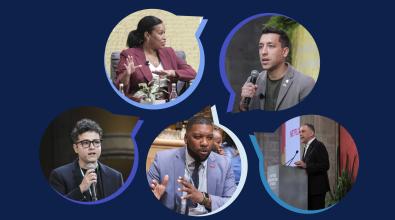Trials show why local governments may want to text their residents more

For local leaders looking to communicate critical messages to the public, breaking through the noise is always a challenge. The pandemic only made the job harder—and more important than ever.
Faced with getting the word out about masks and vaccines, school closings and openings, aid programs, public safety, and so much else, local leaders have tried using social media, email, paid advertising, mailers, and many other channels, often with mixed results.
One technique that appears to be paying off: text messaging.
That’s a key insight from a series of experiments conducted across three U.S. cities over the course of the pandemic. Each trial was unique, testing different types of messaging for distinct purposes: helping residents find work in San Antonio, Texas; preventing evictions in Tulsa, Okla.; and encouraging school attendance in Dayton, Ohio. Yet all came to similar conclusions about the power of texting, also known as SMS—a super-simple tool that most cities have only just begun tapping into.
“Texting is an exciting channel,” says Carolina Toth, Principal Advisor with the Behavioral Insights Team, a group that has worked with dozens of cities to develop and evaluate ideas for improving services using behavioral research. They were a key partner in each of the three trials, which were supported by Bloomberg Philanthropies through its What Works Cities program. “We’re very excited about the promise of SMS as we do trials with cities, and we’re recommending it more and more as a channel for cities to be considering,” Toth says.
Text messaging is nothing new, of course: The first text message was sent 30 years ago and Americans send more than 6 billion texts a day. By now, mobile phone penetration is nearly ubiquitous in the United States, with high adoption rates among people of different racial groups and income levels.
All of that makes texting an attractive communications channel for local governments to experiment with. The city of Anchorage, Alaska, for example, has used texting to get residents connected with the federal food aid program known as SNAP, and to help small business owners access pandemic aid. In Mexico, the city of San Pedro gives residents the option of requesting certain services through another form of instant messaging over WhatsApp.
Tools for using text messaging in sophisticated new ways, using platforms like TextIt or Twillo, have only become more accessible in recent years. Yet for the most part, targeted and two-way uses of texting remain rare among local governments. If cities use texting at all, it’s typically as a broadcasting tool, for communicating one-way messages like emergency alerts.
New use cases
The trials in San Antonio, Tulsa, and Dayton represent new use cases for local leaders to consider, and fresh evidence to inform their thinking.
San Antonio had launched a job-training program for residents in industries hard-hit in the pandemic, such as food service and hospitality. The question was: How best to get the word out and get people signed up?
With assistance from the Behavioral Insights Team, city leaders set up a randomized-control trial. About 30,000 households were identified as potential candidates for the program, based on their having applied for housing assistance earlier in the pandemic. Half of them were sent text messages about the job training offer. The other half received printed postcards in the mail.
[Read our explainer on using randomized control trials in local government]
The response to both channels was small—less than 1 percent of households in the trial went on to sign up for the job-training program. Still, texting showed a clear and statistically significant advantage over the postcard, with double the number of households signing up. What’s more, the cost of sending a text (8 cents per message) was much less than the mailer (40 cents per postcard). “It was twice as effective for a relatively low cost,” Toth says.
The texting trial in Tulsa worked a little differently. There, the city had launched a housing assistance program aimed at helping residents pay rent and avoid eviction. The program was already highly advertised in the community. What Tulsa leaders wanted to know was how much of an additional boost a texting push could provide.
To identify people who might benefit from the housing aid, city officials looked at the city’s water billing data. Residents who were falling behind on water bills, they reasoned, might also be falling behind on rent. They identified more than 10,000 such households and sent half of them a targeted text message about where to call to access financial assistance. The other half received no text message.
The results were clear: Those who received the text message were 18 percent more likely to call about the aid, and 19 percent more likely to get connected to help. As a result, an additional 11 households received $16,500 in housing assistance. That may not sound like a lot, but at a time when Tulsa, like most cities, was struggling to get rental assistance out the door quickly, the text outreach meaningfully accelerated the effort, Toth says.
Power of personalization
Dayton’s texting test had to do with one of the great challenges of the early pandemic period: keeping children engaged during virtual school. Preschoolers were expected to use an evidence-based online literacy and numeracy program called ABC Mouse for at least 45 minutes a week. Schools sent parents regular text messages as a reminder.
To test what kind of message was the most effective, 671 families participated in a randomized-control trial. Half received standard text messages simply encouraging parents to have their kids use the program. The others received a more personalized message. It used the parent’s and child’s names, and cited how many minutes the child had used the program in the previous week.
As it turned out, the latter message worked far better. The children whose parents received a personalized message used the program 50 percent more than those who got the standard message. The lesson: “Personalized SMS can be particularly powerful,” Toth says.
Toth says there are other insights city leaders can take away from these trials. One is that texting is an equitable channel with the power to reach residents across demographic groups. A second is that it’s an accessible form of communication: Texts tend to be short and to the point, compared with other communications channels local governments tend to use, and people tend to check their texts more than they do email. And texting makes it easy for residents to take a desired action, such as calling a hotline or 311 — they’re already on their phones, after all.
“People tend to check their text messages more, versus other forms of communication,” Toth says. “Where maybe bills pile up in the mailbox, or email is just overwhelming, text messages have the power to actually reach somebody. It’s important for cities to have SMS right in there as an option they’re considering.”


